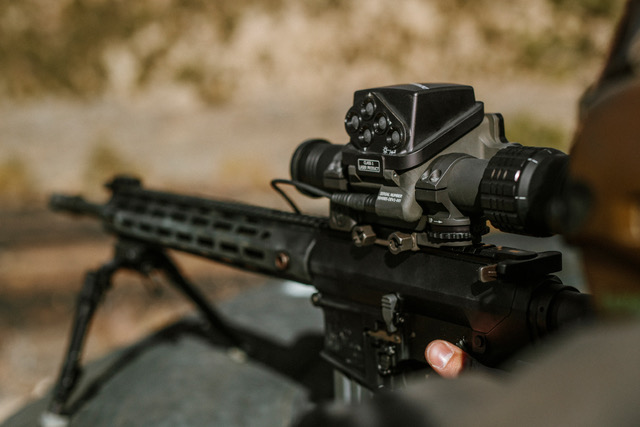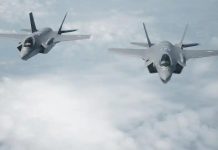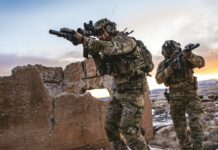SmartPhones made communication faster and easier — putting unprecedented capability into users’ hands. This portable hyper-connectivity provides instant access to information and has limitless potential.
The ELCAN Specter® digital fire control sight, or DFCS, is the first step in the revolution toward intelligent optics that disrupt optical weapon sights like SmartPhones disrupted global communications. The Specter DFCS is ready now and is being used in operational environments with several allied militaries around the world.
“Like the catchphrase used for instant cameras years ago, intelligent optics — or smartoptics — are a point-and-shoot technology,” said Kevin Wagner, senior electrical designer for Raytheon ELCAN, a Raytheon Intelligence & Space subsidiary. “ELCAN digital sights solve problems quicker with less user training required — pushing the battlefield out beyond 600 m.”
Intelligent optics use active technologies like an integrated laser rangefinder to help soldiers solve problems quickly, making them safer and more effective. The smartoptic rapidly calculates distance and translates the data into a ballistic solution.
The ELCAN Specter DFCS sight incorporates rugged, reliable ELCAN optics and advanced sensors — including a laser rangefinder — into a 1-8x zoom scope. Using customized software and a combat-proven ballistic computer chip, the sight calculates a corrected aim-point taking ballistics, distance, humidity, temperature and atmospheric pressure into account. It then evaluates environmental and mission data within seconds and calculates a digitally disturbed reticle. This increases the probability of hitting the target with the first shot, keeping the soldier safer.
The ongoing influence of SWaP-C
The first electronic computer, https://www.britannica.com/technology/ENIAC, was developed to calculate artillery range tables in WWII. It was enormous and generated so much heat that it needed its own air conditioning system. The system completed calculations quicker and more easily than the manual process, but reprogramming took days. It was difficult to imagine computers that weighed tons and took up entire rooms would one day fit in the palm of your hand and deliver solutions instantly.
“We have the core technology and functionality defined,” said Sean Diening, program management lead for Raytheon ELCAN. “Now we’re working to make it smaller, lighter and use less power. The sight will continue to evolve as the technology does.”
The company is working with strategic commercial partners to leverage disruptive technologies like powered rails, wireless power and augmented reality to add advanced capabilities to the sights while reducing the weight.
Overmatch advantage
In a recent test-range field trial, untrained shooters with conventional optics missed every target at 600, 700m and 800m. With the ELCAN Specter DFCS sight, the same shooters hit the targets 100% of the time.
“I saw this myself,” said Wagner. “My colleague is a novice shooter — he went from not hitting the target with conventional optics at 700m to hitting it on the first shot.”
A differentiator of ELCAN sights is the external-mount zeroing. Rather than require a shooter to zero the rangefinder and the sight independently, the ELCAN rangefinder and optic are co-aligned at the factory. Zeroing remains constant and never has to be completed again. The Specter DFCS is faster to zero and faster to engage.
Ongoing development
Improving soldier lethality is a multi-domain challenge, balancing conflicting system requirements like weight and power against the desire to increase capabilities. The ELCAN Specter DFCS 1-8x zoom digital fire control sight enables man-portable capability in the connected battlespace. ELCAN is using a modular approach to smartoptic development.
The next phase of product development will integrate wireless communications and cameras into the sights to allow units and command to share images and information in real-time. Integration of thermal or image-intensified (I2) sensors will enable soldiers to engage 24/7 with one sight.
“ELCAN’s advantage is that we are not just a rifle sight manufacturer, we are an optics innovation centre,” said Wagner. “This next-generation SmartOptic merges our two worlds – the legacy of precision optics combined with research and development to leverage advanced technologies.”
ELCAN’s modular design approach is a multi-year gradient of technology development rather than a fixed horizon. The next steps in ELCAN’s modular design approach will include networked sights, fused sights and advanced sensors.
“Our cross-mission expertise gives us, and our customers, a competitive advantage to future developments,” said Diening. “We are actively investigating how we can incorporate our experience with technologies like LiDAR to push the battlefield out even further to give soldiers an active solution.”
Turning data into usable information – fast
Making the perfect shot takes time — time you don’t always have on the battlefield. Distance amplifies the effect of factors like ballistics and atmospheric pressure. The ELCAN DFCS takes eight data points (temperature, humidity, atmospheric pressure, range, weapon, ammunition, and weapon pitch and roll attitude) and reduces them down to a single, actionable ballistic solution in a split second.
“The solution at sea level and 25 degrees is different than it is at minus 20 in the mountains,” said Diening. “This sight takes all that information into account. It doesn’t just help soldiers see better and farther, but it also helps soldiers and command make better decisions, faster,” said Diening.







